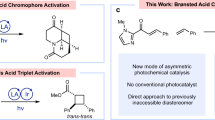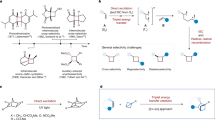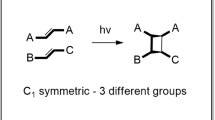Abstract
Photochemical methods are increasingly being used in organic synthesis. They are especially useful for preparing many compounds that are not readily accessible through thermal or enzymatic reactions. The supramolecular strategy has proved highly promising in recent years for manipulating the stereochemical outcome of chiral photoreactions through relatively strong and long-lasting noncovalent interactions in both ground and excited states. Among the numerous chiral photochemical reactions, photocyclodimerization of 2-anthracenecarboxylate (AC) is the most comprehensively studied supramolecular chiral photoreaction and has essentially become a benchmark reaction for evaluating supramolecular photochirogenesis. Cyclodextrin (CD) derivatives were the earliest and are the most widely applied chiral host for mediating photoreactions. Herein, we use CD-mediated photocyclodimerization of AC as an example to introduce the operation process of supramolecular chiral photoreactions. The protocol includes the following contents: (i) the preparation, purification and characterization of β-CD derivatives; (ii) methods for investigating the host–guest inclusion behavior between AC and β-CD derivatives; (iii) the photochemical reaction operation flow under different solvent and temperature conditions; (iv) chiral high-performance liquid chromatography (HPLC) analyses of the product distribution and enantioselectivity. The protocol is introduced by using representative examples of the synthesis of β-CD derivatives and the manipulation of environmental factors that give excellent regio- and enantioselectivities in the photocyclodimerization of AC. The synthesis and purification of β-CD derivatives require 3–5 d of work. The photoirradiation of AC with β-CD derivatives can be done within 1 h. The product analysis requires 5 h.
This is a preview of subscription content, access via your institution
Access options
Access Nature and 54 other Nature Portfolio journals
Get Nature+, our best-value online-access subscription
$29.99 / 30 days
cancel any time
Subscribe to this journal
Receive 12 print issues and online access
$259.00 per year
only $21.58 per issue
Buy this article
- Purchase on Springer Link
- Instant access to full article PDF
Prices may be subject to local taxes which are calculated during checkout











Similar content being viewed by others
Data availability
All relevant data for this protocol can be found in the text and Supplementary Information of this manuscript and/or its supporting primary research papers.
References
Rau, H. Asymmetric photochemistry in solution. Chem. Rev. 83, 535–547 (1983).
Inoue, Y. Asymmetric photochemical reactions in solution. Chem. Rev. 92, 741–770 (1992).
Griesbeck, A. G. & Meierhenrich, U. J. Asymmetric photochemistry and photochirogenesis. Angew. Chem. Int. Ed. 41, 3147–3154 (2002).
Inoue, Y. & Ramamurthy, V. (eds.) Chiral Photochemistry (CRC Press, 2004).
Yang, C. & Inoue, Y. Supramolecular photochirogenesis. in Supramolecular Photochemistry (eds Ramamurthy, V. & Inoue, Y.) 4.115–4.153 (Wiley, 2011).
Yang, C. Recent progress in supramolecular chiral photochemistry. Chin. Chem. Lett. 24, 437–441 (2013).
Yang, C. & Inoue, Y. Supramolecular photochirogenesis. Chem. Soc. Rev. 43, 4123–4143 (2014).
Ramamurthy, V. & Gupta, S. Supramolecular photochemistry: from molecular crystals to water-soluble capsules. Chem. Soc. Rev. 44, 119–135 (2015).
Morimoto, M. et al. Advances in supramolecular host-mediated reactivity. Nat. Catal. 3, 969–984 (2020).
Yao, J. et al. Ammonia-driven chirality inversion and enhancement in enantiodifferentiating photocyclodimerization of 2-anthracenecarboxylate mediated by diguanidino-γ-cyclodextrin. J. Am. Chem. Soc. 136, 6916–6919 (2014).
Rao, M. et al. Photocatalytic supramolecular enantiodifferentiating dimerization of 2-anthracenecarboxylic acid through triplet–triplet annihilation. Org. Lett. 20, 1680–1683 (2018).
Wei, X. et al. Supramolecular photochirogenesis driven by higher-order complexation: enantiodifferentiating photocyclodimerization of 2-anthracenecarboxylate to slipped cyclodimers via a 2:2 complex with β-cyclodextrin. J. Am. Chem. Soc. 140, 3959–3974 (2018).
Ji, J. et al. An ultimate stereocontrol in supramolecular photochirogenesis: Photocyclodimerization of 2-anthracenecarboxylate mediated by sulfur-linked β-cyclodextrin dimers. J. Am. Chem. Soc. 141, 9225–9238 (2019).
Wang, Q. et al. A supramolecular strategy for enhancing photochirogenic performance through host/guest modification: dicationic γ-cyclodextrin-mediated photocyclodimerization of 2,6-anthracenedicarboxylate. Org. Lett. 14, 9757–9761 (2020).
Kanagaraj, K. et al. pH-controlled chirality inversion in enantiodifferentiating photocyclodimerization of 2-antharacenecarboxylic acid mediated by γ-cyclodextrin derivatives. Org. Lett. 22, 5273–5278 (2020).
Luo, L. et al. Cyclodextrin-directed enantioselective photocyclodimerization of methyl 3-methoxyl-2-naphthoate. J. Org. Chem. 74, 3506–3515 (2009).
Brimioulle, R. & Bach, T. Enantioselective lewis acid catalysis of intramolecular enone [2 + 2] photocycloaddition reactions. Science 342, 840–843 (2013).
Coote, S. C. & Bach, T. Enantioselective intermolecular [2 + 2] photocycloadditions of isoquinolone mediated by a chiral hydrogen-bonding template. J. Am. Chem. Soc. 135, 14948–14951 (2013).
Kawanami, Y. et al. Supramolecular photochirogenesis with a higher-order complex: Highly accelerated exclusively head-to-head photocyclodimerization of 2-anthracenecarboxylic acid via 2:2 complexation with prolinol. J. Am. Chem. Soc. 138, 12187–12201 (2016).
Skubi, K. L. et al. Enantioselective excited-state photoreactions controlled by a chiral hydrogen-bonding iridium sensitizer. J. Am. Chem. Soc. 139, 17186–17192 (2017).
Bach, T., Bergmann, H. & Harms, K. Enantioselective intramolecular [2 + 2]-photocycloaddition reactions in solution. Angew. Chem. Int. Ed. 39, 2302–2304 (2000).
Jon, S. Y. et al. A facile, stereoselective [2 + 2] photoreaction mediated by cucurbit [8] uril. Chem. Commun. 1938–1939 (2001).
Pattabiraman, M., Sivaguru, J. & Ramamurthy, V. Cucurbiturils as reaction containers for photocycloaddition of olefins. Isr. J. Chem. 58, 264–275 (2018).
Barrow, S. J. et al. Cucurbituril-based molecular recognition. Chem. Rev. 115, 12320–12406 (2015).
Maddipatla, M. V. S. N. et al. Preorientation of olefins toward a single photodimer: cucurbituril-mediated photodimerization of protonated azastilbenes in water. Langmuir 23, 7545–7554 (2007).
Tanabe, J., Taura, D., Ousaka, N. & Yashima, E. Chiral template-directed regio-, diastereo-, and enantioselective photodimerization of an anthracene derivative assisted by complementary amidinium–carboxylate salt bridge formation. J. Am. Chem. Soc. 139, 7388–7398 (2017).
Urushima, A. et al. Enantiodifferentiating photodimerization of a 2,6-disubstituted anthracene assisted by supramolecular double-helix formation with chiral amines. Angew. Chem. Int. Ed. 59, 7478–7486 (2020).
Wei, X. et al. Reversal of regioselectivity during photodimerization of 2-anthracenecarboxylic acid in a water-soluble organic cavitand. Org. Lett. 21, 7868–7872 (2019).
Yoshizawa, M., Tamura, M. & Fujita, M. Diels–Alder in aqueous molecular hosts: unusual regioselectivity and efficient catalysis. Science 312, 251–254 (2006).
Nishioka, Y., Yamaguchi, T., Kawano, M. & Fujita, M. Asymmetric [2 + 2] olefin cross photoaddition in a self-assembled host with remote chiral auxiliaries. J. Am. Chem. Soc. 130, 8160–8161 (2008).
Alagesan, M. et al. Enantiodifferentiating [4 + 4] photocyclodimerization of 2-anthracenecarboxylate mediated by a self-assembled iron tetrahedral coordination cage. J. Photochem. Photobiol. A 331, 95–101 (2016).
Breslow, R. & Dong, S. D. Biomimetic reactions catalyzed by cyclodextrins and their derivatives. Chem. Rev. 98, 1997–2012 (1998).
Crini, G. Review: a history of cyclodextrins. Chem. Rev. 114, 10940–10975 (2014).
Szejtli, J. Introduction and general overview of cyclodextrin chemistry. Chem. Rev. 98, 1743–1754 (1998).
Rekharsky, M. V. & Inoue, Y. Complexation thermodynamics of cyclodextrins. Chem. Rev. 98, 1875–1918 (1998).
Hanessian, S., Benalil, A. & Laferriere, C. The synthesis of functionalized cyclodextrins as scaffolds and templates for molecular diversity, catalysis, and inclusion phenomena. J. Org. Chem. 60, 4786–4797 (1995).
Fukuhara, G. et al. Supramolecular photocyclodimerization of 2-hydroxyanthracene with a chiral hydrogen-bonding template, cyclodextrin and serum albumin. Photochem. Photobiol. Sci. 13, 162–171 (2014).
Rao, V. P. & Turro, N. J. Asymmetric induction in benzoin by photolysis of benzaldehyde adsorbed in cyclodextrin cavities. Tetrahedron Lett. 30, 4641–4644 (1989).
Inoue, Y. et al. Inclusion-enhanced optical yield and E/Z ratio in enantiodifferentiating photoisomerization of cyclooctene included and sensitized by β-cyclodextrin monobenzoate. J. Am. Chem. Soc. 117, 11033–11034 (1995).
Fukuhara, G., Mori, T., Wada, T. & Inoue, Y. Entropy-controlled supramolecular photochirogenesis: enantiodifferentiating Z–E photoisomerization of cyclooctene included and sensitized by permethylated 6-O-benzoyl-β-cyclodextrin. Chem. Commun. 4199–4201 (2005).
Lu, R. et al. Supramolecular enantiodifferentiating photoisomerization of cyclooctene with modified beta-cyclodextrins: critical control by a host structure. Chem. Commun. 374–376 (2008).
Nakamura, A. & Inoue, Y. Supramolecular catalysis of the enantiodifferentiating [4 + 4] photocyclodimerization of 2-anthracenecarboxylate by γ-cyclodextrin. J. Am. Chem. Soc. 125, 966–972 (2003).
Nakamura, A. & Inoue, Y. Electrostatic manipulation of enantiodifferentiating photocyclodimerization of 2-anthracenecarboxylate within γ-cyclodextrin cavity through chemical modification. Inverted product distribution and enhanced enantioselectivity. J. Am. Chem. Soc. 127, 5338–5339 (2005).
Yang, C. et al. Highly Stereoselective photocyclodimerization of α-cyclodextrin-appended anthracene mediated by γ-cyclodextrin and cucurbit[8]uril: a dramatic steric effect operating outside the binding site. J. Am. Chem. Soc. 130, 8574–8575 (2008).
Yang, C. et al. Dual supramolecular photochirogenesis: ultimate stereocontrol of photocyclodimerization by a chiral scaffold and confining host. J. Am. Chem. Soc. 133, 13786–13789 (2011).
Koodanjeri, S., Joy, A. & Ramamurthy, V. Asymmetric induction with cyclodextrins: photocyclization of tropolone alkyl ethers. Tetrahedron 56, 7003–7009 (2000).
Shailaja, J., Karthikeyan, S. & Ramamurthy, V. Cyclodextrin mediated solvent-free enantioselective photocyclization of N-alkyl pyridones. Tetrahedron Lett. 43, 9335–9339 (2002).
Koodanjeri, S. & Ramamurthy, V. Cyclodextrin mediated enantio and diastereoselective geometric photoisomerization of diphenylcyclopropane and its derivatives. Tetrahedron Lett. 43, 9229–9232 (2002).
Wada, T. et al. Bovine serum albumin-mediated enantiodifferentiating photocyclodimerization of 2-anthracenecarboxylate. J. Am. Chem. Soc. 125, 7492–7493 (2003).
Fuentealba, D. et al. Explaining the highly enantiomeric photocyclodimerization of 2-anthracenecarboxylate bound to human serum albumin using time-resolved anisotropy studies. J. Am. Chem. Soc. 135, 203–209 (2013).
Nishijima, M. et al. Photochirogenesis with mutant human serum albumins: enantiodifferentiating photocyclodimerization of 2-anthracenecarboxylate. Chem. Commun. 49, 7433–7435 (2013).
Ishida, Y. et al. Two-component liquid crystals as chiral reaction media: highly enantioselective photodimerization of an anthracene derivative driven by the ordered microenvironment. Angew. Chem. Int. Ed. 47, 8241–8245 (2008).
Ishida, Y. et al. Metastable liquid crystal as time-responsive reaction medium: aging-induced dual enantioselective control. J. Am. Chem. Soc. 135, 6407–6410 (2013).
Wei, X. et al. Enantioselective photoinduced cyclodimerization of a prochiral anthracene derivative adsorbed on helical metal nanostructures. Nat. Chem. 12, 551–559 (2020).
Chen, X.-Y. et al. Selective photodimerization in a cyclodextrin metal–organic framework. J. Am. Chem. Soc. 143, 9129–9139 (2021).
Tamaki, T., Kokubu, T. & Ichimura, K. Regio- and stereoselective photodimerization of anthracene derivatives included by cyclodextrins. Tetrahedron 43, 1485–1494 (1987).
Yang, C. et al. Pressure and temperature-controlled enantiodifferentiating [4 + 4] photocyclodimerization of 2-anthracenecarboxylate mediated by secondary face- and skeleton-modified gamma-cyclodextrins. J. Org. Chem. 71, 3126–3136 (2006).
Yang, C., Mori, T. & Inoue, Y. Supramolecular enantiodifferentiating photocyclodimerization of 2-anthracenecarboxylate mediated by capped γ-cyclodextrins: critical control of enantioselectivity by cap rigidity. J. Org. Chem. 73, 5786–5794 (2008).
Ke, C. et al. Catalytic enantiodifferentiating photocyclodimerization of 2-anthracenecarboxylic acid mediated by a non-sensitizing chiral metallosupramolecular host. Angew. Chem. Int. Ed. 48, 6675–6677 (2009).
Yang, C. et al. Enantiodifferentiating photocyclodimerization of 2-anthracenecarboxylic acid mediated by γ-cyclodextrins with a flexible or rigid cap. Org. Lett. 8, 3005–3008 (2006).
Vallavoju, N. & Sivaguru, J. Supramolecular photocatalysis: combining confinement and non-covalent interactions to control light initiated reactions. Chem. Soc. Rev. 43, 4084–4101 (2014).
Welborn, V. V. & Head-Gordon, T. Electrostatics generated by a supramolecular capsule stabilizes the transition state for carbon–carbon reductive elimination from gold(III) complex. J. Phys. Chem. Lett. 9, 3814–3818 (2018).
Young, T. A. et al. Rationalizing the activity of an “artificial diels-alderase”: establishing efficient and accurate protocols for calculating supramolecular catalysis. J. Am. Chem. Soc. 142, 1300–1310 (2020).
Petroselli, M. et al. Radical reactions in cavitands unveil the effects of affinity on dynamic supramolecular systems. J. Am. Chem. Soc. 142, 2396–2403 (2020).
Wei, X. et al. Enhanced irregular photodimers and switched enantioselectivity by solvent and temperature in the photocyclodimerization of 2-anthracenecarboxylate with modified β-cyclodextrins. J. Photochem. Photobiol. A 371, 374–381 (2019).
Nishijima, M. et al. High-sensitivity HPLC quantification of nonfluorescent but photolabile analyte through photoreversion in fluorescence detector. Chem. Lett. 39, 726–727 (2009).
Bouas-Laurent, H. et al. Photodimerization of anthracenes in fluid solution: structural aspects. Chem. Soc. Rev. 29, 43–55 (2000).
Bouas-Laurent, H. et al. Photodimerization of anthracenes in fluid solutions: (part 2) mechanistic aspects of the photocycloaddition and of the photochemical and thermal cleavage. Chem. Soc. Rev. 30, 248–263 (2001).
Wang, Q. et al. Wavelength-controlled supramolecular photocyclodimerization of anthracenecarboxylate mediated by γ-cyclodextrins. Chem. Commun. 47, 6849–6851 (2011).
Acknowledgements
We acknowledge the support of this work by the National Key Research and Development Program of China (2017YFA0505903), the National Natural Science Foundation of China (92056116, 22001046, 21871194, 21971169 and 21572142), the Fundamental Research Funds for the Central Universities (20826041D4117), the Comprehensive Training Platform of Specialized Laboratory (College of Chemistry, Sichuan University), the Department of Education, Science and Technology of Guangxi Zhuang Autonomous Region (2020KY03008, 2020AC19233 and 2021JJB120031) and the Youth Science Foundation of Guangxi Medical University (GXMUYSF201904).
Author information
Authors and Affiliations
Contributions
C.Y. and W.W. designed the experiments and supervised the project. X.W. and J.J. contributed equally to this work. They designed and performed the experiments. Y.N. and L.T. performed some of the experiments. M.R., X.W., D.S. and Z.Z. composed the manuscript. All the authors reviewed and approved the manuscript.
Corresponding authors
Ethics declarations
Competing interests
The authors declare no competing interests.
Peer review
Peer review information
Nature Protocols thanks Axel Griesbeck, Yoshihisa Inoue and Yasuhiro Ishida for their contribution to the peer review of this work.
Additional information
Publisher’s note Springer Nature remains neutral with regard to jurisdictional claims in published maps and institutional affiliations.
Related Links
Key references using this protocol
Wei, X. et al. J. Am. Chem. Soc. 140, 3959–3974 (2018): https://doi.org/10.1021/jacs.7b12085
Ji, J. et al. J. Am. Chem. Soc. 141, 9225–9238 (2019): https://doi.org/10.1021/jacs.9b01993
Key data used in this protocol
Ji, J. et al. J. Am. Chem. Soc. 141, 9225–9238 (2019): https://doi.org/10.1021/jacs.9b01993
Extended data
Extended Data Fig. 1 Glassware setup for synthesis of 11 and 12.
a,b, Photographs of the state of the pyridine solution containing 100 mM β-CD before (a) and after the addition of p-toluenesulfonyl chloride dissolved in pyridine for 4 h (b). The reaction mixture was vigorously stirred under Ar protection with an inflated Ar balloon.
Extended Data Fig. 2 Glassware setup and TLC example for synthesis of 13 and 14.
a, Glassware setup for synthesis of 6A,6C-diiodo-β-CD 13 or 6A,6D-diiodo-β-CD 14. b, Iodination for 6A,6C-di-O-tosyl-β-CD 11 monitored by TLC (the TLC Rf values of 6A,6X-di-O-tosyl-β-CD and 6A,6X-diiodo-β-CD are 0.6 and 0.5, respectively, using isopropanol/EtOAc/H2O/NH3∙H2O (5:2:3:1 (vol/vol/vol/vol) as eluent).
Extended Data Fig. 3 Glassware setup.
Glassware setup for synthesis of 6A,6C-TMA2-β-CD 7 or 6A,6D-TMA2-β-CD 8.
Supplementary information
Supplementary Information
Supplementary Figs. 1–33.
Rights and permissions
About this article
Cite this article
Wei, X., Ji, J., Nie, Y. et al. Synthesis of cyclodextrin derivatives for enantiodifferentiating photocyclodimerization of 2-anthracenecarboxylate. Nat Protoc 17, 2494–2516 (2022). https://doi.org/10.1038/s41596-022-00722-6
Received:
Accepted:
Published:
Issue Date:
DOI: https://doi.org/10.1038/s41596-022-00722-6
This article is cited by
-
Mirror-image cyclodextrins
Nature Synthesis (2024)
Comments
By submitting a comment you agree to abide by our Terms and Community Guidelines. If you find something abusive or that does not comply with our terms or guidelines please flag it as inappropriate.



